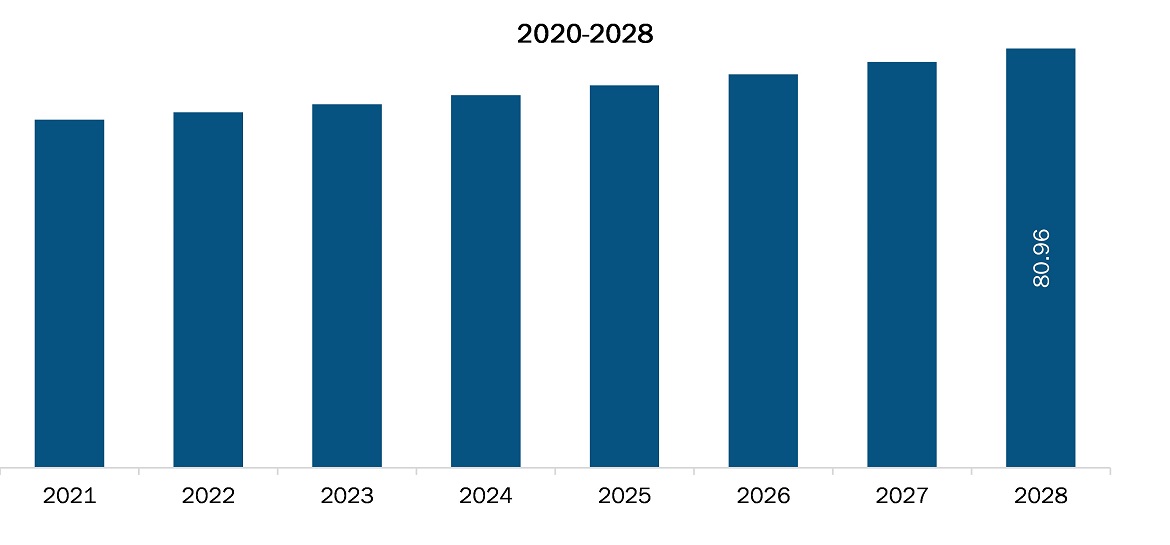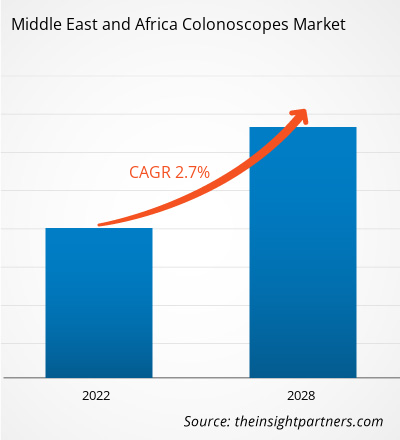The Middle East and Africa colonoscopes market is expected to reach US$ 80.96 million by 2028 from an estimated value of US$ 67.24 million in 2021; it is likely to grow at a CAGR of 2.7% from 2021 to 2028.
The factors attributed to driving the growth of market are the increasing prevalence of colorectal cancer, technological advancements in colonoscopy devices and growing research activities to extend its applications in therapeutic areas and development of robotic colonoscopes. However, the availability of alternative diagnostic tests for rectal diseases may hamper the growth of the Middle East and Africa colonoscopes market in the forecast period.
The success rate of diagnosing colorectal conditions, including cancer, has increased with advancements in technologies. Flexible endoscopy is an effective method enabling the early diagnosis and treatment of gastrointestinal cancer, making it a popular choice for screening. However, a large population that benefits from endoscopic colorectal cancer screening feels skeptical about undergoing the procedure. This is mainly ascribed to psychological barriers due to the indignity of the process, fear of procedure-related pain, discomfort in bowel preparation, and potential need for sedation, which underlines an urgent need for new technologies for addressing these issues. To significantly reduce the adenoma “miss rate” of standard forward-viewing colonoscopy, manufacturers are continuously striving to improve the current colonoscopy techniques, by exploring more advanced optics and wider-angle visualization tools along with a user-friendly, intuitive endoscopic platform interface. The introduction of such technologies is fuelling the colonoscope market growth. Also, march is marked as the National Colorectal Awareness Month, dedicated to encouraging patients, survivors, and caregivers to share their stories, advocate for colorectal cancer prevention, and inform others about the importance of early detection. Thus, growing awareness about the effect of colon disorders will increase the adoption of colonoscopy tests during the forecast period, thus offering lucrative opportunities to the market players.
The coronavirus has had a significant impact in the Middle East and Africa. COVID-19 has been linked to poorer outcomes in cancer patients. Saudi Arabia has seen multiple Middle East respiratory syndrome coronavirus (MERS-CoV) outbreaks that affected the continuity of cancer care. Colon cancer (CRC) is the fifth most common cancer in Lebanon and the country with the second-highest incidence of the disease in the Middle East and North Africa (MENA) region, with more than 90% of colorectal cancer cases occurring in people aged 50 and over. The pandemic has increased demand for medical devices, which can use in-home care. The region is witnessing an increase in the number of patients being admitted to intensive care units (ICU), an increasing number of drugs that pose multiple diagnostic and therapeutic challenges to strained health systems, leading to an increase in medical devices. There have been changes in staff assignments and working hours and the implementation of strict infection control and social distancing measures. However, segments of the medical industry, including colonoscopes devices, suffered losses during the COVID-19 pandemic due to limited production and supply chain facilities. This pandemic is affecting the business operations of the various key players operating in the colonoscopes market in the region hampering the market growth.

- This FREE sample will include data analysis, ranging from market trends to estimates and forecasts.
MIDDLE EAST AND AFRICA COLONOSCOPES MARKET SEGMENTATION
By Product Type
- Fiber Optic Colonoscopy Devices
- Video Colonoscopy Devices
By Application
- Colorectal Cancer
- Lynch Syndrome
- Ulcerative Colitis
- Crohn's Disease
- Polyp
By End User
- Hospitals
- Ambulatory Surgery Center
- Other End Users
By Country
- UAE
- South Africa
- Saudi Arabia
- Rest of Middle East and Africa
Company Profiles
- Fujifilm Corporation
- Olympus Corporation
- KARL STORZ SE & Co. KG
- PENTAX Medical
- Boston Scientific Corporation
- Consis Medical
- GI-View
- SonoScape Medical Corp.
Middle East and Africa Colonoscopes Report Scope
| Report Attribute | Details |
|---|---|
| Market size in 2021 | US$ 67.24 Million |
| Market Size by 2028 | US$ 80.96 Million |
| Global CAGR (2021 - 2028) | 2.7% |
| Historical Data | 2019-2020 |
| Forecast period | 2022-2028 |
| Segments Covered |
By Product Type
|
| Regions and Countries Covered | Middle East and Africa
|
| Market leaders and key company profiles |
- Historical Analysis (2 Years), Base Year, Forecast (7 Years) with CAGR
- PEST and SWOT Analysis
- Market Size Value / Volume - Global, Regional, Country
- Industry and Competitive Landscape
- Excel Dataset



Report Coverage
Revenue forecast, Company Analysis, Industry landscape, Growth factors, and Trends

Segment Covered
This text is related
to segments covered.

Regional Scope
North America, Europe, Asia Pacific, Middle East & Africa, South & Central America

Country Scope
This text is related
to country scope.
Trends and growth analysis reports related to Life Sciences : READ MORE..
- Fujifilm Corporation
- Olympus Corporation
- KARL STORZ SE & Co. KG
- PENTAX Medical
- Boston Scientific Corporation
- Consis Medical
- GI-View
- SonoScape Medical Corp.

 Get Free Sample For
Get Free Sample For